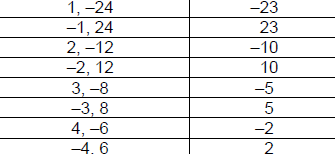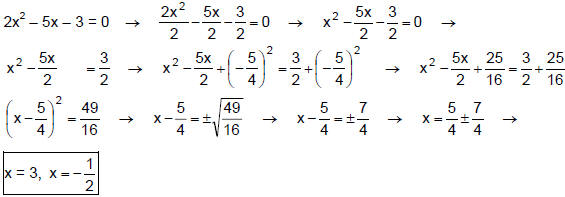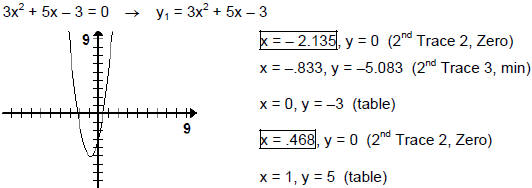Functions, Equations, and Inequalities
2.3 Quadratic Equations, Functions, and Models
I. Definitions of a Quadratic Equation and a Quadratic Function
A quadratic equation in standard form is an equation equivalent to ax2 + bx + c
= 0 where a, b,
and c are real numbers and a ≠ 0. X-values which make the equation true are
called the solutions
or roots of the equation. A quadratic equation can have at most two solutions /
roots.
A quadratic function is a function which can be written in the form f(x) = ax2 +
bx + c where a, b,
and c are real numbers and a ≠ 0. X-values which make f(x) = 0 are called the
zeros of the
function. A quadratic function can have at most two zeros.
The real zeros of a function are the first coordinates of the x-intercepts of
the graph of the
function. The graph of a quadratic function can have at most two x-intercepts.
II. Equation-Solving Principles
| The Principle of Zero Products: |
If a·b = 0, then a = 0, b = 0, or both = 0. If a = 0, b = 0, or both = 0, then a·b = 0. |
| The Principle of Square Roots: | If x2 = k, then  or
or  . . |
| The Quadratic Formula: | If ax2 + bx + c = 0, then
 . . |
III. Five Methods of Solving Quadratic Equations
A. Solving Quadratic Equations by Factoring and Using the Zero Products
Principle
1. Put equation in standard form. Factor out the greatest common factor (GCF).
2. Look for patterns such as a difference of squares, x2 – y2 = (x – y)·(x + y)
or
a perfect square trinomial, x2 + 2xy + y2 = (x + y)2 or x2 – 2xy + y2 = (x –
y)2.
3. If there is no pattern, factor by trial and error or factor by grouping.
If you don’t remember how to factor, you should review section R4.
4. Once you have factored, set each factor equal to zero and solve.
Example 1
Solve the equation 12x3 – 8x = –10x2 by factoring. (like # 17 & 18 pg.
213)
12x3 + 10x2 – 8x = 0
2x (6x2 + 5x – 4) = 0
Factoring 6x2 + 5x – 4:
6 × –4 = –24 → We are looking for two factors of –24 that add up to 5.
| Pairs of Factors of –24 | Sums of Factors |
 |
|
The pair that we are looking for is –3, 8. We can now
rewrite 5x as 8x – 3x. And then
factor by grouping.

B. Solving Quadratic Equations by Using the Square Roots
Principle
Note: This is the best method to use if the quadratic equation does not have an
x term.
It is also called extracting the roots.
1. Isolate the squared term which contains the variable.
2. Take the square root of both sides. Be sure you put ± in front of the radical
on the
right side.
3. Solve for the variable.
Example 2
Solve 4x2 + 12 = 0. (# 12 pg. 213)

C. Solving Quadratic Equations by Using the Quadratic Formula
1. Write the equation in standard form.
2. Identify a (the coefficient of the squared term), b (the coefficient of the
1st degree
term) and c (the constant).
3. Plug a, b, & c into the Quadratic Formula.
4. Solve for x. Write the solutions in simplified form.
Example 3
Solve 5x2 + 3x = 1 by using the quadratic formula. (# 50 pg. 214)

D. Solving Quadratic Equations by Completing the Square
1. Write the equation in standard form. If a ≠ 1, divide every term by a.
2. Subtract the constant from both sides of the equation.
3. Add  to both sides of the equation.
Remember, b is the coefficient of the
to both sides of the equation.
Remember, b is the coefficient of the
constant term.
4. Rewrite the left side as  . Simplify the
right side.
. Simplify the
right side.
5. Solve by extracting the roots.
Example 4
Solve 2x2 – 5x – 3 = 0 by completing the square.
(# 34 pg. 213)

E. Solving Quadratic Equations Graphically
1. Put the equation in standard form, ax2 + bx + c = 0
2. Enter ax2 + bx + c at  .
.
3. Graph the equation and adjust the window so that you can see all of the
x-intercepts.
4. Use 2nd Trace 2 (root or zero) to find all of the zeros.
Note: This same basic process can be used to solve any equation with real
solutions.
You can also solve an equation graphically by entering the left side as
 , the
right side
, the
right side
as  , and then using 2nd Trace 5 (Intersect) to find the x-values of the points
of
, and then using 2nd Trace 5 (Intersect) to find the x-values of the points
of
intersection.
Example 5
Solve 3x2 + 5x = 3 graphically. Round solutions to 3 decimal places.
(# 116 pg. 215)

III Solving Equations which are Quadratic in Form ax2n + bxn + c = 0
1. Rewrite the equation as a quadratic by substituting u for the expression
following b.
i.e., Let u = xn, then rewrite ax2n + bxn + c = 0 as au2 + bu + c = 0.
2. Solve for u.
3. Back substitute u values in to xn = u and solve for x.
Example 6
Solve x4 + 3x2 = 10. (# 79 pg. 214
x4 + 3x2 – 10 = 0 Let u = x2. Then the equation becomes u2 + 3u – 10 = 0
u2 + 3u – 10 = 0 → (u + 5) (u – 2) = 0 → u + 5 = 0, u – 2 = 0 →
u = –5, u = 2 Replace u with x2→x2= –5, x2 = 2 →

IV. Useful Formulas for Solving Quadratic Applications
Pythagorean Theorem: For a right triangle with legs a & b and hypotenuse c, a2 +
b2 = c2.
Area of a Rectangle: A = L·W
Perimeter of a Standard Rectangle: P = 2L + 2W
Volume of a Box: V = L · W · H
Example 7
The director of the Glen Island Zoo wants to use 170 m of fencing to
enclose a
petting area of 1750 m2. Find the dimensions of the petting area. (#104 pg. 215)
 |
 W = 50 m or 35 m → If W = 35 m, then L = 85 – 35 = 50 m. → 35 m by 50 m N.B.: We usually let the smaller dimension be the width and the larger dimension be the length |
Example 8
One leg of a right triangle is 7 cm. The other leg is 1 cm less than
the hypotenuse.
Find the length of the hypotenuse and the length of the second leg. (like # 98
pg. 214)


